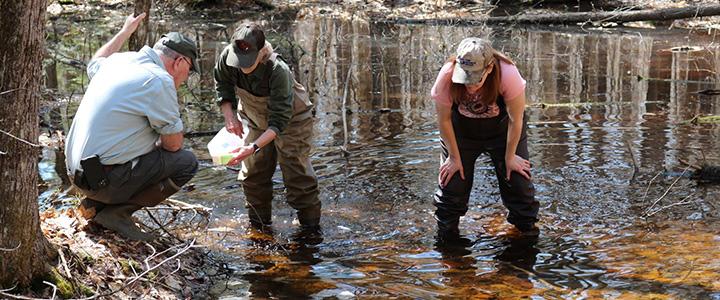
Commissioner's Column: Celebrating Wetlands for Their Incalculable Value
It was another lovely Earth Day in New Hampshire on April 22, and I took the opportunity to celebrate it by joining NHDES staff and partners on a field visit to a local vernal pool to study the area for evidence of amphibian and salamander eggs. Vernal pools are a type of wetland that provides critical wildlife breeding habitat, and they typically only “appear” from March to May every year. It’s a good time to get out and see one for yourself, but please maintain a safe, respectful distance from any wildlife when you do so.
May is also American Wetlands Month, an observation that dates back to 1991, which also gives us a great excuse to enjoy these areas and learn more about their importance in our environment. Vernal pools are one of several diverse forms of wetlands found in New Hampshire. Some others include forested wetlands, tidal marshes, mudflats, swamps, bogs and wet meadows. Only an estimated 5-10% of New Hampshire lands are wetlands. Like rain forests or coral reefs, wetlands are among nature’s most productive ecosystems. They provide almost incalculable value to our environment. They support plants and animals, soil formation, erosion protection, and especially flood control. They also help remove nutrients, toxins and sediment before waters return to our local drinking water supplies. Common water pollutants that wetlands help remove include nitrates, ammonium, phosphorus, and pesticides. Wetlands also store massive amounts of carbon in their plants and soils, which would otherwise be released as carbon dioxide.
In addition to our environmental health, wetlands contribute to our economic health. They support sustainable forestry, shellfish harvesting and water for livestock. They support hiking, paddling, fishing, bird watching, photography, duck hunting, travel and tourism, and in many cases even real estate. Previous studies suggest the economic value of a single wetland acre is between $150,000 to $200,000. Related studies suggest the economic value of New Hampshire’s remaining wetlands exceeds $1 billion.
Did you know New Hampshire was one of the first states to regulate the protection of wetlands? Jurisdiction began for tidal wetlands in 1967 and for nontidal wetlands in 1969. Since then, our Legislature has consistently recognized the importance of this resource.
I enjoyed my trip to one of our local vernal pools and getting a chance to put eyes on some wood frog and salamander egg clusters, and also getting a peek at some fairy shrimp, which I understand are not always that easy to find. I want to thank the NHDES Land Resources Management staff and the members of the Bow Conservation Commission for showing me around. My visit certainly helped to reinforce with me the importance of the work we do here at NHDES every day. We look forward to providing natural resource protection and excellent service to our customers in the years and decades ahead. For our environment, and for our economy, thank you for supporting the health of New Hampshire lands and waters.




